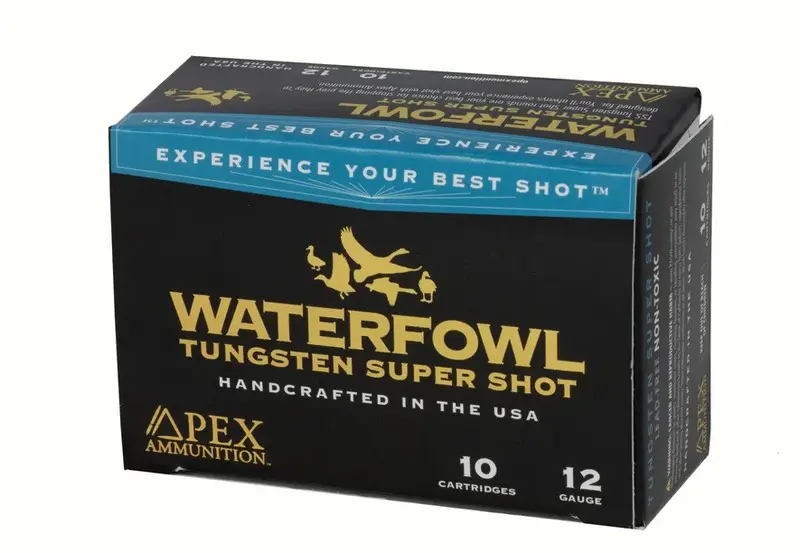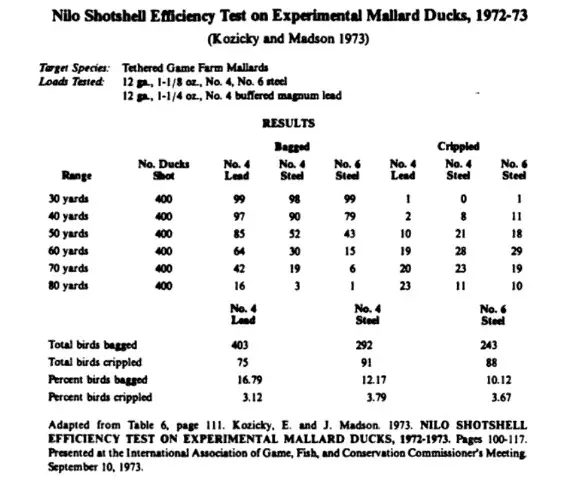High Performance Shot and 90 Yard Loads

As noted by Ed Lowry and others, the laws of physics and specifically, the laws of motion don't change from year to year. Higher initial velocity steel loads are of minimal benefit, as it is strike velocity that counts, not the original velocity nor the amount of air a pellet needs to kill on the way to its target. Spherical steel flies best, but it is still steel so ranges are reduced accordingly to retain the same clean kill probability as lead. Don Zutz rejected the two sizes up theory for steel, opting instead for #1 steel as ideal for ducks including teal.
What is the range difference?
The best available version of the truth is that anything over thirty-five yards is considered "long range" for steel. Assuming the proper choke and better than average pattern placement, 40 yards is a good approximation. With lead loads, the better lead loads such as buffered loads, again assuming proper choke and better than average ability to place a pattern, a reasonable approximation for lead (or shot materials with density similar to lead) is 50 yards. That suggests about 25% more effective range with buffered lead compared to steel.
The term "approximation" is purposely inserted. Certainly, some will claim steel is "good" (whatever that means) to 45 yards or so. At the same time, some will claim that the best buffered lead loads are "good" to 50 or 55 yards. You might note that those who consider themselves to be excellent shots sometimes brag about "one and a half shells per duck," or two ducks for every three steel shells expended. That of course indicates that one shot, one kill fails to happen over 33% of the time. The superiority of denser than steel materials is what got Edward Lowry so excited about the bismuth potential in the first place. Lowry was practical enough frame his comments about bismuth in terms of "potential," though, as the propensity of bismuth to fracture was a serious issue, as was the misshapen pellets, as was the inability of the Bleimeister process to produce acceptable bismuth shot above #5 in diameter. We have far better shot materials today that are approved for waterfowl.
The only reason to use steel is cost as better density, as better performing shot materials suitable for all guns have long been available as Kent Tungsten Matrix and, more recently, Nice Shot. Nice Shot has now vanished. The highest density generally available loaded ammunition some years back was Federal Heavyweight, a superlative performer for the same reason that Lowry identified from the two most extensive shotshell lethality studies ever conducted: “if two pellets deposited the same amount of lethal energy, the smaller one's energy is more lethally effective.” Using the best ammunition and choke you can afford isn't bad advice. That's part of what makes a sport a sport and not just poorly-advised or sloppy noise-making. How badly we decide to compromise ourselves in the field by not patterning our guns, not practicing, and using inappropriate ammunition for the game at the ranges we decide to shoot at is entirely up to us. It is largely about the respect we show our game that we electively hunt. The primary focus and responsibility of the sportsman is on his quarry, not himself. Density is problem with steel and that has never changed. Sphericity (roundness) is a main problem with lead, as well as legality. Bismuth still has fracturing and brittleness problems.

Tungsten
Super Shot at 18/g cc is both incredibly dense and spherical. At one
time, #4 lead was considered the best long-range mallard load. A one
ounce load of Tungsten Super Shot has 25% more pellets than a 1-1/2
oz. of #4 lead. Yet, the Tungsten has a high strike velocity at 60
yards (about 100 fps higher) and about 40% more penetration at 60
yards as well. TSS #8 has about the same penetration at 90 yards
as #4 lead has at 60 yards. As stunning as it may sound, TSS #8
has 50% more effective range than #4 lead. As TSS #8 is smaller
diameter, it displaces less air, and has substantially less drop and
wind drift than #4 lead as well.
Every credible wounding ballistics study for wingshooting waterfowl and pheasants has come to the same conclusion: it takes 3-4 pellets in the torso of the bird for a clean kill. It is a little more complicated than it sounds, for a passing or angling shot has a relatively large kill zone, yet when all you have to shoot at is “pheasant butt” presents a very small kill zone.
Wildlife Research Report, Volume 17, from Indiana Division of Fish and Game (1956) documented from five thousand one hundred sixty-one waterfowl hunters (mostly ducks, but also geese, and coots) that “Hunters reported expending 26,862 shells for an average of 6.8 shells expended for each bird bagged.” There have been a variety of studies, most coming to the similar conclusion that 5-6 shots are expended for every recovered duck. An older Field & Stream article cited a study about dove hunting: “dove are a boon to munition makers, with a kill ratio of one bird for every seven shells expended.” It hasn't changed much today, for an average of five shots are expended for every dead duck. Is it the ammo (steel), failure to pattern shotguns, just bad shooting, or what?

Long range shooting with shotguns is not a new idea. The Nilo Farms tests on mallards went out to 80 yards. You can see that at 70 and 80 yards, #4 lead was not very effective, and steel at those ranges was essentially ineffectual. Part of the problem with the lead #4 "buffered magnum" 1-1/4 oz. loads uses is the pellet count. It is only about 169 pellets and that isn't enough to well-populate a pattern at 70 or 80 yards.
Yet, 1 oz. of TSS #8 is 251 pellets. Bump it to 1-1/4 oz. TSS #8, and it is about 314 pellets. Lethality is not the issue, as TSS #8 at 90 yards does what lead #4 does at 60 yards. The wingshooting pattern isn't the same school of thought as turkey patterns. For wingshooting, you want the largest pattern possible at the ranges you want to shoot at, while maintaining the 3-4 torso hits that means 100% game recovery.We can't rely on the one magic neck-seeking guided missile pellet found somewhere in a shotshell.
A 1550 fps 1 oz. TSS #8 load was not a random selection, for that is the standard Z-12 Apex Ammunition Waterfowl load. It may not be a 90 yard load with 1 oz., the pattern board will show exactly what it is, but it will undoubtedly be an effective 70-75 yard load on most anything that flies.
Not
everyone has interest in long-distance shotshell performance. However,
as the evil dark psychic forces of the Empire generate lead hysteria,
you can also view Tungsten Super Shot as salvation of sorts for the 28
and 20 gauges.You can also view it as a great way to reduce payload
weight and greatly reduce recoil in concert with that payload reduction.
An enthusiastic waterfowler may well have a $10,000 SxS ATV, a $2000 trailer to pull it, $1000 in decoys and calls, another $1000 or more in waders, boots, jackets, gloves, $5000 (or more) invested in a couple of dogs, and might take it on on the road with a $50,000 Jeep Grand Cherokee Trailhawk. You probably want a hunting license and a shotgun as well. With gas, food, vet bills, insurance, regardless of how you add it all up, it can be a big fat chunk of change. Then, there are blinds and perhaps a boat. That's why some don't view ammunition cost as a large percentage of total hunting costs. If traveling to South Dakota for pheasants, with a limit of three roosters a day, ammunition becomes a very small factor indeed. Your mileage and your costs will vary.
Copyright 2020 by Randy Wakeman. All Rights Reserved.












